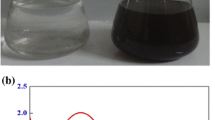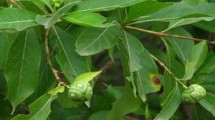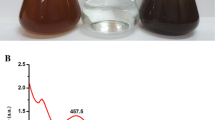Abstract
Malaria is a life-threatening disease caused by parasites transmitted to people and animals through the bites of infected mosquitoes. The employ of synthetic insecticides to control Anopheles populations leads to high operational costs, non-target effects, and induced resistance. Recently, plant-borne compounds have been proposed for efficient and rapid extracellular synthesis of mosquitocidal nanoparticles. However, their impact against predators of mosquito larvae has been poorly studied. In this study, we synthesized silver nanoparticles (AgNPs) using the Datura metel leaf extract as reducing and stabilizing agent. The biosynthesis of AgNPs was confirmed analyzing the excitation of surface plasmon resonance using ultraviolet–visible (UV–vis) spectroscopy. Scanning electron microscopy (SEM) showed the clustered and irregular shapes of AgNPs, with a mean size of 40–60 nm. The presence of silver was determined by energy-dispersive X-ray (EDX) spectroscopy. Fourier transform infrared (FTIR) spectroscopy analysis investigated the identity of secondary metabolites, which may be acting as AgNP capping agents. In laboratory, LC50 of D. metel extract against Anopheles stephensi ranged from 34.693 ppm (I instar larvae) to 81.500 ppm (pupae). LC50 of AgNP ranged from 2.969 ppm (I instar larvae) to 6.755 ppm (pupae). Under standard laboratory conditions, the predation efficiency of Anax immaculifrons nymphs after 24 h was 75.5 % (II instar larvae) and 53.5 % (III instar larvae). In AgNP-contaminated environment, predation rates were boosted to 95.5 and 78 %, respectively. Our results documented that D. metel-synthesized AgNP might be employed at rather low doses to reduce larval populations of malaria vectors, without detrimental effects on behavioral traits of young instars of the dragonfly Anax immaculifrons.




Similar content being viewed by others
References
Ali A, Ahmad F, Biondi A, Wang Y, Desneux N (2012) Potential for using Datura alba leaf extracts against two major stored grain pests, the khapra beetle Trogoderma granarium and the rice weevil Sitophillus oryzae. J Pest Sci 85:359–366
Amer A, Mehlhorn H (2006a) Repellency effect of forty-one essential oils against Aedes, Anopheles and Culex mosquitoes. Parasitol Res 99:478–490
Amer A, Mehlhorn H (2006b) The sensilla of Aedes and Anopheles mosquitoes and their importance in repellency. Parasitol Res 99:491–499
Amer A, Mehlhorn H (2006c) Larvicidal effects of various essential oils against Aedes, Anopheles, and Culex larvae (Diptera, Culicidae). Parasitol Res 99:466–472
Amer A, Mehlhorn H (2006d) Persistency of larvicidal effects of plant oil extracts under different storage conditions. Parasitol Res 99:473–477
Arjunan NK, Murugan K, Rejeeth C, Madhiyazhagan P, Barnard DR (2012) Green synthesis of silver nanoparticles for the control of mosquito vectors of malaria, filariasis, and dengue. Vector-Born Zoon Dis 12:262–268
Baun A, Hartmann NB, Grieger K, Kusk KO (2008) Ecotoxicity of engineered nanoparticles to aquatic invertebrates: a brief review and recommendations for future toxicity testing. Ecotoxicology 17:387–395
Benelli G (2015a) Research in mosquito control: current challenges for a brighter future. Parasitol Res 114:2801–2805
Benelli G (2015b) Plant-borne ovicides in the fight against mosquito vectors of medical and veterinary importance: a systematic review. Parasitol Res 114:3201–3212
Benelli G (2015c) Plant-synthesized nanoparticles in the fight against mosquito vectors: an eco-friendly tool against mosquito vectors. In: Mehlhorn H, editor. Nanoparticles in the fight against parasites. Parasitology Research Monographs, Springer, ISSN: 536 2192–3671, in press
Benelli G, Murugan K, Panneerselvam C, Madhiyazhagan P, Conti B, Nicoletti M (2015) Old ingredients for a new recipe? Neem cake, a low-cost botanical by-product in the fight against mosquito-borne diseases. Parasitol Res 114:391–397
Bouyer J, Lefrançois T (2014) Boosting the sterile insect technique to control mosquitoes. Trends Parasitol 30:271–273
Bowatte G, Perera P, Senevirathne G, Meegaskumbura S, Meegaskumbura M (2013) Tadpoles as dengue mosquito (Aedes aegypti) egg predators. Biol Control 67:469–47
Chakkaravarthy VM, Ambrose T, Vincent S, Arunachalam R, Paulraj MG, Ignacimuthu S, Annadurai G (2011) Bioefficacy of Azadirachta indica (A. Juss) and Datura metel (Linn.) leaves extracts in controlling Culex quinquefasciatus (Diptera: Culicidae). J Entomol 8:191–197
Dhas TS, Kumar VG, Karthick V, Angel KJ, Govindaraju K (2014) Facile synthesis of silver chloride nanoparticles using marine alga and its antibacterial efficacy. Spectrochim Acta Part A: Mol Biomol Spectrosc 120:416
Dinesh D, Murugan K, Madhiyazhagan P, Panneerselvam C, Nicoletti M, Jiang W, Benelli G, Chandramohan B, Suresh U (2015) Mosquitocidal and antibacterial activity of green-synthesized silver nanoparticles from Aloe vera extracts: towards an effective tool against the malaria vector Anopheles stephensi? Parasitol Res 114:1519–29
Fabrega J, Luoma SN, Tyler CR, Galloway TS, Lead JR (2011) Silver nanoparticles: behaviour and effects in the aquatic environment. Environ Int 37:517–531
Fincke OM, Yanoviak SP, Hanschu RD (1997) Predation by odonates depresses mosquito abundance in water-filled tree holes in Panama. Oecologia 112:244–253
Finney DJ (1971) Probit analysis. Cambridge University Press, London
Goodsell DS (2004) Bionanotechnology: lessons from nature. Wiley, Hoboken
Haldar KM, Haldar B, Chandra G (2013) Fabrication, characterization and mosquito larvicidal bioassay of silver nanoparticles synthesized from aqueous fruit extract of putranjiva, Drypetes roxburghii (Wall.). Parasitol Res 112:1451–1459
Jensen M, Mehlhorn H (2009) Seventy-five years of Resochin® in the fight against malaria. Parasitol Res 105:609–627
Kasthuri J, Kanthiravan K, Rajendiran N (2008) Phyllanthin-assisted biosynthesis of silver and gold nanoparticles: a novel biological approach. J Nanoparticle Res 15:1075–1085
Kaviya S, Santhanalakshmi J, Viswanathan B, Muthumary J, Srinivasan K (2011) Biosynthesis of silver nanoparticles using Citrus sinensis peel extract and its antibacterial activity. Spectrochim Acta Part A: Mol Biomol Spectrosc 79:594–598
Kesharwani J, Yoon KY, Hwang J, Rai M (2009) Phytofabrication of silver nanoparticles by leaf extract of Datura metel: hypothetical mechanism involved in synthesis. J Bionanosci 3(1):39–44
Kong H, Jang J (2006) One-step fabrication of silver nanoparticle embedded polymer nanofibers by radical-mediated dispersion polymerization. Chem Comm (Camb): 3010–3012
Kumar R, Hwang JS (2006) Larvicidal efficiency of aquatic predators: a perspective for mosquito biocontrol. Zool Stud 45:447–466
Kumral NA, Cobanoglu S, Yalcin C (2010) Acaricidal, repellent and oviposition deterrent activities of Datura stramonium L. against adult Tetranychus urticae (Koch). J Pest Sci 83:173–180
Lacey LA, Orr BK (1994) The role of biological control of mosquitoes in integrated vector control. Am J Trop Med Hyg 50:97–115
Liu H, Xu Q, Zhang L, Liu N (2005) Chlorpyrifos resistance in mosquito Culex quinquefasciatus. J Med Entomol 42(5):815–820
Medlock JM, Snow KR (2008) Natural predators and parasites of British mosquitoes – a review. Eur Mosq Bull 25:1–11
Mehlhorn H (ed) (2011) Nature helps. How plants and other organisms contribute to solve health problems. Parasitology Research Monographs. Springer, Berlin, pp 1–372
Mehlhorn H, Schmahl G, Schmidt J (2005) Extract of the seeds of the plant Vitex agnus castus proven to be highly efficacious as a repel- lent against ticks, fleas, mosquitoes and biting flies. Parasitol Res 95:363–365
Mehlhorn H, Al-Rasheid KA, Al-Quraishy S, Abdel-Ghaffar F (2012) Research and increase of expertise in arachno-entomology are urgently needed. Parasitol Res 110:259–265
Morones JR, Elechiguerra JL, Camacho A, Holt K, Kouri JB, Ramirez JT (2005) The bactericidal effect of silver nanoparticles. J Nanotechnol 16:2346–53
Murugan K, Hwang SJ, Kovendan K, Kumar KP, Vasugi C, Kumar AN (2011) Use of plant products and copepods for control of the dengue vector, Aedes aegypti. Hydrobiologia 666:331–338
Murugan K, Benelli G, Ayyappan S, Dinesh D, Panneerselvam C, Nicoletti M, Hwang JS, Mahesh Kumar P, Subramaniam J, Suresh U (2015a) Toxicity of seaweed-synthesized silver nanoparticles against the filariasis vector Culex quinquefasciatus and its impact on predation efficiency of the cyclopoid crustacean Mesocyclops longisetus. Parasitol Res 114:2243–53
Murugan K, Benelli G, Panneerselvam C, Subramaniam J, Jeyalalitha T, Dinesh D, Nicoletti M, Hwang JS, Suresh U, Madhiyazhagan P (2015b) Cymbopogon citratus-synthesized gold nanoparticles boost the predation efficiency of copepod Mesocyclops aspericornis against malaria and dengue mosquitoes. Exp Parasitol 153:129–138
Murugan K, Priyanka V, Dinesh D, Madhiyazhagan P, Panneerselvam C, Subramaniam J, Suresh U, Chandramohan B, Roni M, Nicoletti M, Alarfaj AA, Higuchi A, Munusamy MA, Khater HF, Messing RH, Benelli G (2015c) Enhanced predation by Asian bullfrog tadpoles, Hoplobatrachus tigerinus, against the dengue vector Aedes aegypti in an aquatic environment treated with mosquitocidal nanoparticles. Parasitol Res. doi:10.1007/s00436-015-4582-0
Murugan K, Venus JSE, Panneerselvam C, Bedini S, Conti B, Nicoletti M, Kumar Sarkar S, Hwang JS, Subramaniam J, Madhiyazhagan P, Mahesh Kumar P, Dinesh D, Suresh U, Benelli G (2015d) Biosynthesis, mosquitocidal and antibacterial properties of Toddalia asiatica-synthesized silver nanoparticles: do they impact predation of guppy Poecilia reticulata against the filariasis mosquito Culex quinquefasciatus? Environ Sci Poll Res. doi:10.1007/s11356-015-4920-x
Murugan K, Sanoopa CP, Madhiyazhagan P, Dinesh D, Subramaniam J, Panneerselvam C, Roni M, Suresh U, Nicoletti M, Alarfaj AA, Munusamy MA, Higuchi A, Kumar S, Perumalsamy H, Ahn JY, Benelli G (2015e) Rapid biosynthesis of silver nanoparticles using Crotalaria verrucosa leaves against the dengue vector Aedes aegypti: what happens around? An analysis of dragonfly predatory behaviour after exposure at ultra-low doses. Nat Prod Res. doi:10.1080/14786419.2015.1074230
Muthukumaran U, Govindarajan M, Rajeswary M, Hoti SL (2015) Synthesis and characterization of silver nanoparticles using Gmelina asiatica leaf extract against filariasis, dengue, and malaria vector mosquitoes. Parasitol Res. doi:10.1007/s00436-015-4368-4
Nicoletti M, Mariani S, Maccioni O, Coccioletti T, Murugan K (2012) Neem cake: chemical composition and larvicidal activity on Asian tiger mosquito. Parasitol Res 111:205–2013
Oberdorster E, Zhu S, Michelle Blickley T, McClellan-Green P, Haasch ML (2006) Ecotoxicology of carbon-based engineered nanoparticles: effects of fullerene (C60) on aquatic organisms. Carbon 44:1112–1120
Oliva CF, Damiens D, Benedict MQ (2014) Male reproductive biology of Aedes mosquitoes. Acta Trop 132S:S512–S19
Panneerselvam C, Murugan K, Kovendan K, Mahesh Kumar P (2012) Mosquito larvicidal, pupicidal, adulticidal, and repellent activity of Artemisia nilagirica (Family: Compositae) against Anopheles stephensi and Aedes aegypti. Parasitol Res 111:2241–2251
Panneerselvam C, Murugan K, Kovendan K, Mahesh Kumar P, Subramaniam J (2013) Mosquito larvicidal and pupicidal activity of Euphorbia hirta Linn. (Family: Euphorbiaceae) and Bacillus sphaericus against Anopheles stephensi Liston. (Diptera: Culicidae). (Diptera: Culicidae). Asian Pac J Trop Med 6:102–109
Park J, Kim S, Yoo J, Lee JS, Park JW, Jung J (2014) Effect of salinity on acute copper and zinc toxicity to Tigriopus japonicus: the difference between metal ions and nanoparticles. Marine Poll Bull 85:526–531
Patil CD, Borase HP, Patil SV, Salunkhe RB, Salunke BK (2012) Larvicidal activity of silver nanoparticles synthesized using Pergularia daemia plant latex against Aedes aegypti and Anopheles stephensi and nontarget fish Poecillia reticulata. Parasitol Res 111:555–562
Pavela R (2015) Essential oils for the development of eco-friendly mosquito larvicides: a review. Ind Crops Prod 76:174–187
Petit C, Lixon P, Pileni MP (1993) In situ synthesis of silver nanocluster in AOT reverse micelles. J Phys Chem 97:12974–12983
Ponarulselvam S, Panneerselvam C, Murugan K, Aarthi A, Kalimuthu K, Thangamani S (2012) Synthesis of silver nanoparticles using leaves of Catharanthus roseus Linn. G. Don and their antiplasmodial activities. Asian-Pacific J Trop Biomed 574–580
Priya SK, Gnanamani A, Radha Krishnan N, Babu M (2002) Healing potential of Datura metel on burn wounds in albino rats. J Ethnopharmacol 83:193–199
Priyadarshini AK, Murugan K, Panneerselvam C, Ponarulselvam S, Hwang J-S, Nicoletti M (2012) Biolarvicidal and pupicidal potential of silver nanoparticles synthesized using Euphorbia hirta against Anopheles stephensi Liston (Diptera: Culicidae). Parasitol Res 111:997–1006
Rajan R, Chandran K, Harper SL, Yun SI, Kalaichelvan PT (2015) Plant extract synthesized nanoparticles: an ongoing source of novel biocompatible materials. Ind Crop Prod 70:356–373
Rajasekharreddy P, Usha Rani P, Sreedhar B (2010) Qualitative assessment of silver and gold nanoparticle synthesis in various plants: a photobiological approach. J Nanopart Res 12:1711–1721
Rajesh, Sharma GL (2002) Studies on antimycotic properties of Datura metel. J Ethnopharmacol 80:193–197
Rawani A, Ghosh A, Chandra G (2013) Mosquito larvicidal and antimicrobial activity of synthesized nano-crystalline silver particles using leaves and green berry extract of Solanum nigrum L. (Solanaceae: Solanales). Acta Trop 128:613–622
Robert LL, Olson JK (1989) Susceptibility of female Aedes albopictus from Texas to commonly used adulticides. J Am Mosq Control Assoc 5:251–253
Roni M, Murugan K, Panneerselvam C, Subramaniam J, Nicoletti M, Madhiyazhagan P, Dinesh D, Suresh U, Khater HF, Wei H, Canale A, Alarfaj AA, Munusamy MA, Higuchi A, Benelli G (2015) Characterization and biotoxicity of Hypnea musciformis-synthesized silver nanoparticles as potential eco-friendly control tool against Aedes aegypti and Plutella xylostella. Ecotoxicol Environ Saf. doi:10.1016/j.ecoenv.2015.07.005
Satyavani K, Ramanathan T, Gurudeeban S (2011) Plant mediated synthesis of biomedical silver nanoparticles by using leaf extract of Citrullus colocynthis. Res J Nanosci Nanotechnol 1:95–101
Savithramma N, Rao ML, Rukmini K, Devi PS (2011) Antimicrobial activity of silver nanoparticles synthesized by using medicinal plants. Int J Chem Tech Res 3:1394–1402
Semmler M, Abdel-Ghaffar F, Al-Rasheid KAS, Mehlhorn H (2009) Nature helps: from research to products against blood sucking arthropods. Parasitol Res 105:1483–1487
Shankar S, Rai A, Ahmad A, Sastry M (2004) Rapid synthesis of Au, Ag and bimetallic Au core-Ag shell nanoparticles using Neem (Azadirachta indica) leaf broth. J Colloid Inter Sci 275:496–502
Singh RK, Dhiman RC, Singh SPJ (2003) Laboratory studies on the predatory potential of dragon-fly nymphs on mosquito larvae. Commun Dis Jun 35:96–101
Song JY, Kim BS (2009) Rapid biological synthesis of silver nanoparticles using plant leaf extracts. Bioprocess Biosyst Eng 32:79–84
Soni N, Prakash S (2012) Efficacy of fungus mediated silver and gold nanoparticles against Aedes aegypti larvae. Parasitol Res 110:175–184
Stav G, Blaustein L, Margalit Y (2000) Influence of nymphal Anax imperator (Odonata: Aeshnidae) on oviposition by the mosquito Culiceta longiareolata (Diptera: Culicidae) and community structure in temporary pools. J Vect Ecol 25:190–202
Suresh U, Murugan K, Benelli G, Nicoletti M, Barnard DR, Panneerselvam C, Mahesh Kumar P, Subramaniam J, Dinesh D, Chandramohan B (2015) Tackling the growing threat of dengue: Phyllanthus niruri-mediated synthesis of silver nanoparticles and their mosquitocidal properties against the dengue vector Aedes aegypti (Diptera: Culicidae). Parasitol Res 114:1551–1562
Susanto H, Feng Y, Ulbricht M (2009) Fouling behavior of aqueous solutions of polyphenolic compounds during ultrafiltration. J Food Eng 91:333–340
Thilagam M, Tamilselvi A, Chandrasekeran B, Rose C (2013) Phytosynthesis of silver nanoparticles using medicinal and dye yielding plant of Bixa orellana L. leaf extract. J Pharma Sci Innov 2:9–13
Ukiya M, Akihisa T, Yasukawa K, Kasahara Y, Kimura Y, Koike K, Nikaido T, Takido M (2001) Constituents of composite plants. 2. Triterpene diols, triols, and their 3-o-fatty acid esters from edible chrysanthemum flower extract and their anti-inflammatory effects. J Agric Food Chem 49:3187–3197
Ward JV (1992) Aquatic insect ecology, volume 1: biology and habitat. Wiley, New York
Wattanachai P, Tintanon B (1999) Resistance of Aedes aegypti to chemical compounds in aerosol insecticide products in different areas of Bangkok Thailand. Commun Dis J 25:188–191
Westfall MJ Jr, May ML (1996) Damselflies of North America. Scientific Publishers, Gainesville
WHO (2014) Malaria. Fact sheet N 94
Yanoviak SP (2001) Predation, resource availability and community structure in Neotropical water filled tree holes. Oecologia 126:125–133
Yanoviak SP (2004) Predation, resource availability and community structure in Neotropical water-filled tree holes. Oecologia 126:125–133
Acknowledgments
The Authors would like to thank the Deanship of Scientific Research, King Saud University, for supporting this study (project RG-1435-057). The funder had no role in the study design, data collection and analysis, decision to publish, or preparation of the manuscript.
Conflict of interest
The authors declare no conflicts of interest. Heinz Mehlhorn and Giovanni Benelli are Editor in Chief and Editorial Board Member of Parasitology Research, respectively. This does not alter the authors’ adherence to all the Parasitology Research policies on sharing data and materials.
Compliance with ethical standards
All applicable international and national guidelines for the care and use of animals were followed. All procedures performed in studies involving animals were in accordance with the ethical standards of the institution or practice at which the studies were conducted.
Informed consent
Informed consent was obtained from all individual participants included in the study.
Author information
Authors and Affiliations
Corresponding author
Rights and permissions
About this article
Cite this article
Murugan, K., Dinesh, D., Kumar, P.J. et al. Datura metel-synthesized silver nanoparticles magnify predation of dragonfly nymphs against the malaria vector Anopheles stephensi . Parasitol Res 114, 4645–4654 (2015). https://doi.org/10.1007/s00436-015-4710-x
Received:
Accepted:
Published:
Issue Date:
DOI: https://doi.org/10.1007/s00436-015-4710-x




